Dogo Argentino
Adobe Stock/tyurina
The Dogo Argentino was developed in the Republic of Argentina by a breeder named Dr. Antonio Nores Martinez. He focused on crossbreeding large, hardworking dogs to create an excellent partner for big-game hunting, according to the Dogo Argentino Club of America (DACA).
The Dogo Argentino’s size reaches up to 27 inches at the shoulder, and the dogs weigh 80–100 pounds. The muscular breed is tenacious, intelligent, and loyal. Because Dogo Argentinos were originally bred to be hunting dogs, they are loyal and energetic companions.
Caring for a Dogo Argentino
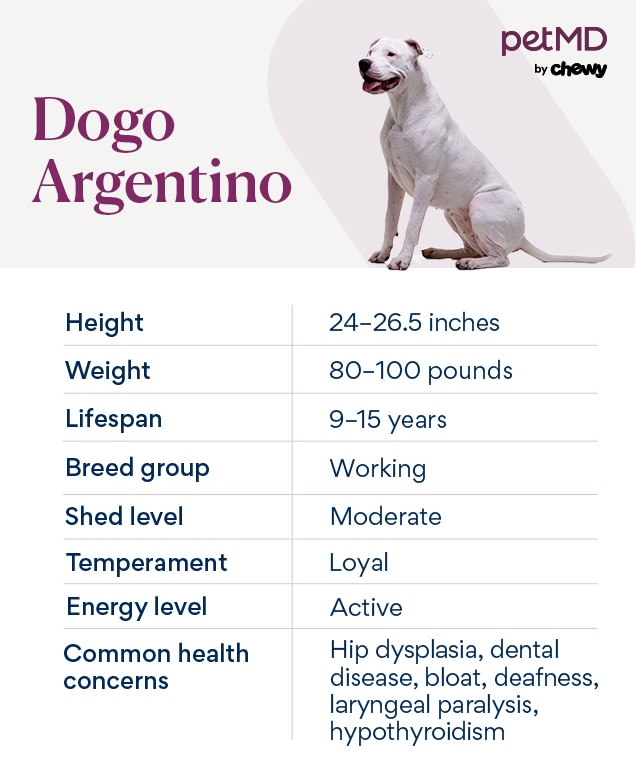
The Dogo Argentino has a short, smooth white coat. Occasional bathing is recommended, but intensive brushing and coat maintenance is not necessary. That said, Dogo Argentino dogs shed regularly, and brushing will help reduce this.
This breed is thick and muscular, with a bulky, boxy head and heavy jowls that make them moderate droolers.
Because these dogs are athletically built and energetic, they require lots of daily exercise, such as long walks, running, and playing fetch. Dogo Argentinos can become destructive when they’re bored, so regular exercise is also important for maintaining their mental well-being as well as their physical health.
They can be independent-minded when it comes to training, so a Dogo Argentino requires experienced pet parents to ensure an appropriate upbringing.
Dogo Argentino Health Issues
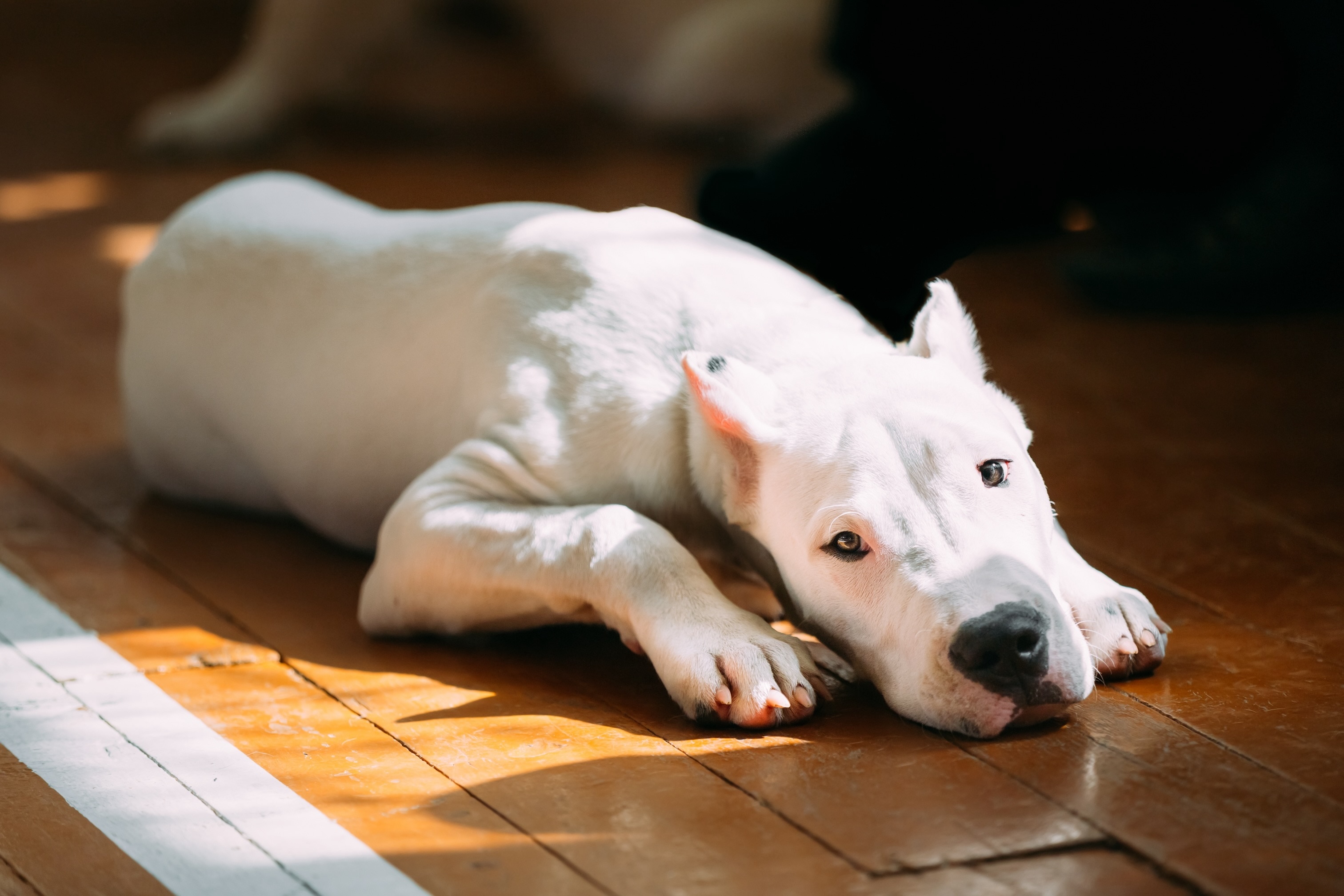
The Dogo Argentino is generally a very healthy dog with an average lifespan of 9–15 years, but they can develop some conditions common in large breed dogs and also specific disorders due to their genetic predisposition.
You can gain further insight into your Dogo Argentino’s health by screening them for over 230 genetic health risks with a dog DNA test.
Hip Dysplasia
Hip dysplasia is a common orthopedic disorder affecting large dog breeds. It results from an inherited defect of the hip joint, due to the ball (head of the thigh bone) and socket (in the pelvis) not aligning normally.
Hip dysplasia can develop severe arthritis, a debilitating disease that causes progressive pain and difficulty moving as the dog ages.
Talk to your vet if you notice any signs of hip dysplasia in your Dogo Argentino, such as limping, difficulty rising from rest, a bunny-hopping gait, or reluctance to run, jump, or go up and down stairs. Treatment depends on the hip dysplasia’s severity and can range from weight management, joint support changes, exercise, and NSAIDs to corrective surgery.
Periodontal Disease
Dental disease is a common ailment among all dogs and cats. The Dogo Argentino isn’t susceptible to more dental diseases than other large breeds, but pet parents still need to maintain their Dogo’s dental hygiene at home to prevent tartar buildup and gingivitis.
Once tartar starts to accumulate on teeth, it can be very difficult to remove. Brushing your dog’s teeth at least three times per week (though ideally every day) is recommended. Annual dental cleanings with a veterinarian are also strongly advised once a Dogo Argentino turns 2 years old.
Gastric Dilatation-Volvulus (GDV)
Gastric dilatation-volvulus, a severe form of bloat in dogs, is an emergency condition that occurs in large, deep-chested dogs like the Dogo Argentino. It consists of the stomach bloating and flipping over itself in a way that stops blood supply to the organ. If not addressed immediately, GDV is fatal.
To prevent this from happening, a gastropexy procedure is recommended in young Dogo Argentino dogs at the time of their spaying or neutering surgeries. A gastropexy secures the stomach to the interior body wall, preventing it from flipping in cases of bloat.
Deafness
Dogo Argentino puppies can be born deaf, and deafness in these dogs is typically related to their white coat color. Deaf dogs can live long and relatively normal lives with a few care adjustments from their pet parents, like using hand signals instead of verbal cues during training.
Laryngeal Paralysis
Laryngeal paralysis is typically caused by a disorder with the nerve that opens and closes the larynx, or vocal folds, of large-breed dogs. This disorder causes the folds to open only partially or to not open at all.
A poorly functioning larynx can cause increased breathing sounds or actual difficulty with breathing. This disorder can be managed surgically in moderate to severe cases.
Hypothyroidism
Hypothyroidism (underactive thyroid) occurs when a dog’s thyroid gland doesn’t produce enough thyroid hormone. Low levels of thyroid hormone can cause weight gain, disorders with a dog’s coat, increased susceptibility to ear and skin infections, and low energy. This condition can develop in middle-aged dogs and is managed with lifelong medication.
Dogo Argentino and other large or giant dogs are more likely than smaller breeds to develop hypothyroidism.
What To Feed a Dogo Argentino
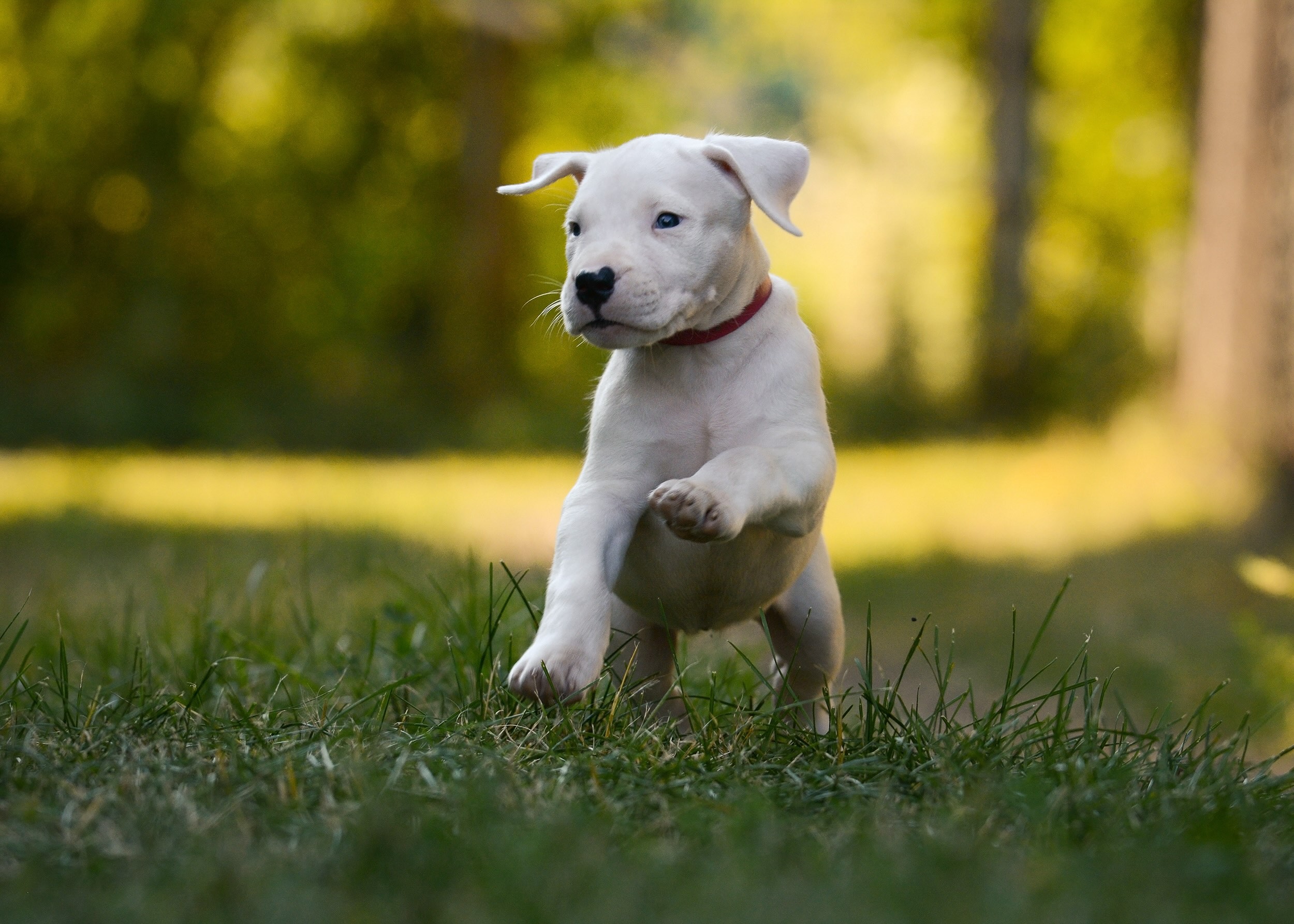
All dogs must eat a food that meets the Association of American Feed Control Officials (AAFCO) nutritional guidelines. This ensures your Dogo Argentino receives a complete and balanced diet.
Because of their size, Dogo Argentinos need to eat a food formulated for large breeds. Dogo Argentino puppies need to eat a puppy food for large breeds for the right balance of nutrients for their fast-growing bodies. If Dogo Argentinos grow too large too quickly, this puts their joints at risk of developing problems.
How To Feed a Dogo Argentino
Most adult dogs do well with two meals per day. As puppies, Dogo Argentinos should be fed more often—up to three times daily. Speak with your veterinarian about the best way to feed your puppy.
Dogo Argentinos can be particularly eager eaters, so slow-feeding bowls come in handy to prevent rapid food ingestion. Dogs that eat too quickly often inhale large amounts of air, which can lead to bloating and life-threatening episodes of GDV.
Other ways to prevent bloat and GDV include:
-
Restricting exercise just before and after your Dogo eats
-
Avoiding elevated food bowls
-
Feeding your dog two or three meals every day instead of one big meal
How Much Should You Feed a Dogo Argentino?
Always work with your veterinarian to determine the right amount of food to feed your dog, as this varies depending on your Dogo Argentino’s weight, lifestyle, health, and other factors. Preventing obesity in your dog is important, as obesity can cause or worsen certain health conditions.
Nutritional Tips for the Dogo Argentino
A dog eating an AAFCO-compliant dog food should receive all needed nutrients, but your vet may prescribe a dog supplement on a case by case basis, such as:
-
Fish oil supplements that contain omega-3, -6, and -9 fatty acids help support the health of the skin and haircoat, heart, kidneys, and joints.
-
A joint supplement containing methylsulfonylmethane (MSM), glucosamine, and chondroitin may be recommended because Dogo Argentino dogs are prone to developing arthritis and hip dysplasia.
Your veterinarian will be able to direct you to specific supplement brands and let you know how to give them to your dog safely.
Behavior and Training Tips for a Dogo Argentino
Dogo Argentino Personality and Temperament
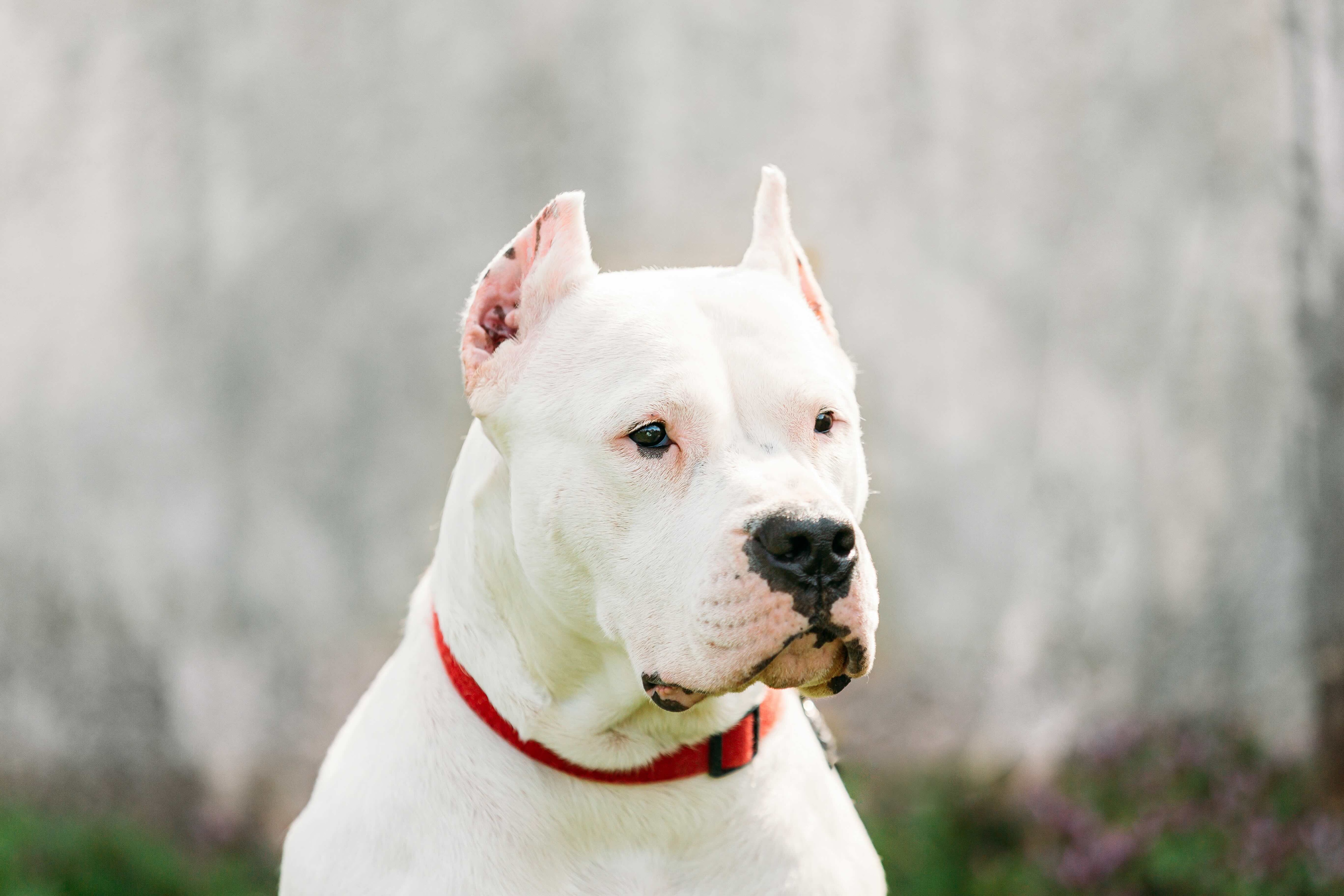
A Dogo Argentino’s personality traits are influenced by their history as big game hunters. They are energetic, courageous dogs that are affectionate with and loyal to their family members.
Dogo Argentinos may be reserved around strangers at first. But when they’re well-socialized and properly introduced to new people and animals, Dogos can be friendly and laid-back.
They can make good playmates for older children who know how to properly interact with dogs, thanks to the Dogo’s energetic nature. Always supervise children and dogs when they are together.
Dogo Argentino Behavior
These dogs tend to be quiet and won’t bark excessively, but they do have a strong prey drive since they were bred to be hunting dogs. Dogo Argentinos need to be on a leash or kept inside of fenced-in areas to prevent them from running after small animals, like neighborhood rabbits or squirrels.
Unsupervised Dogo Argentinos tend to eat things they shouldn’t or get into mischief. To keep your Dogo safe, happy, and healthy, always keep a watchful eye on them and follow a daily schedule designed to wear out their physical and mental energy.
Dogo Argentino Training
Dogo Argentinos might not be a good dog for first-time pet parents because they come with a high energy level and a strong prey drive. They’re smart dogs but were bred to work independently, which means they can have a mind of their own and require patience for training.
Always use positive reinforcement training methods with a Dogo Argentino and make training sessions engaging and fun. It’s also important to begin socializing your Dogo Argentino puppy early so they grow to be comfortable and confident in new situations and with people and pets outside their household.
Fun Activities for Dogo Argentinos
-
Playing ball
-
Walking or running on leash
-
Hunting
Dogo Argentino Grooming Guide
Dogo Argentinos have short, soft coats and are moderate shedders. They can be bathed once or twice weekly, or as needed when excessively dirty. Dogos do not have coats that require detangling or clipping.
Skin Care
Dogo Argentinos do not typically have sensitive skin, but they can have non-pigmented regions of skin under their white hair, making them prone to sunburn.
Be careful about allowing them to lounge in direct sunlight for long periods of time—this includes hanging their head out of the car window during long drives. Dog-safe sunscreen can help keep their skin from burning.
Coat Care
Dogo Argentinos have a short coat that isn’t at risk of matting but will shed regularly year-round. Regular brushing can help remove loose hair and keep it from ending up on your floor and furniture.
Eye Care
Because of their white coat, Dogo Argentino can develop tear stains under their eyes. These can be easily wiped away with dog tear stain removers.
Talk to your vet if you notice any changes in your dog’s eyes, such as discharge, redness, or cloudiness.
Ear Care
The Dogo Argentino breed doesn’t have special needs aside from regular ear care. Your veterinarian will advise you if a regular ear cleaning schedule is recommended in the case of chronic ear infections, and how often to clean their ears at home. Ask your vet which ear cleaning products to use.
Considerations for Pet Parents
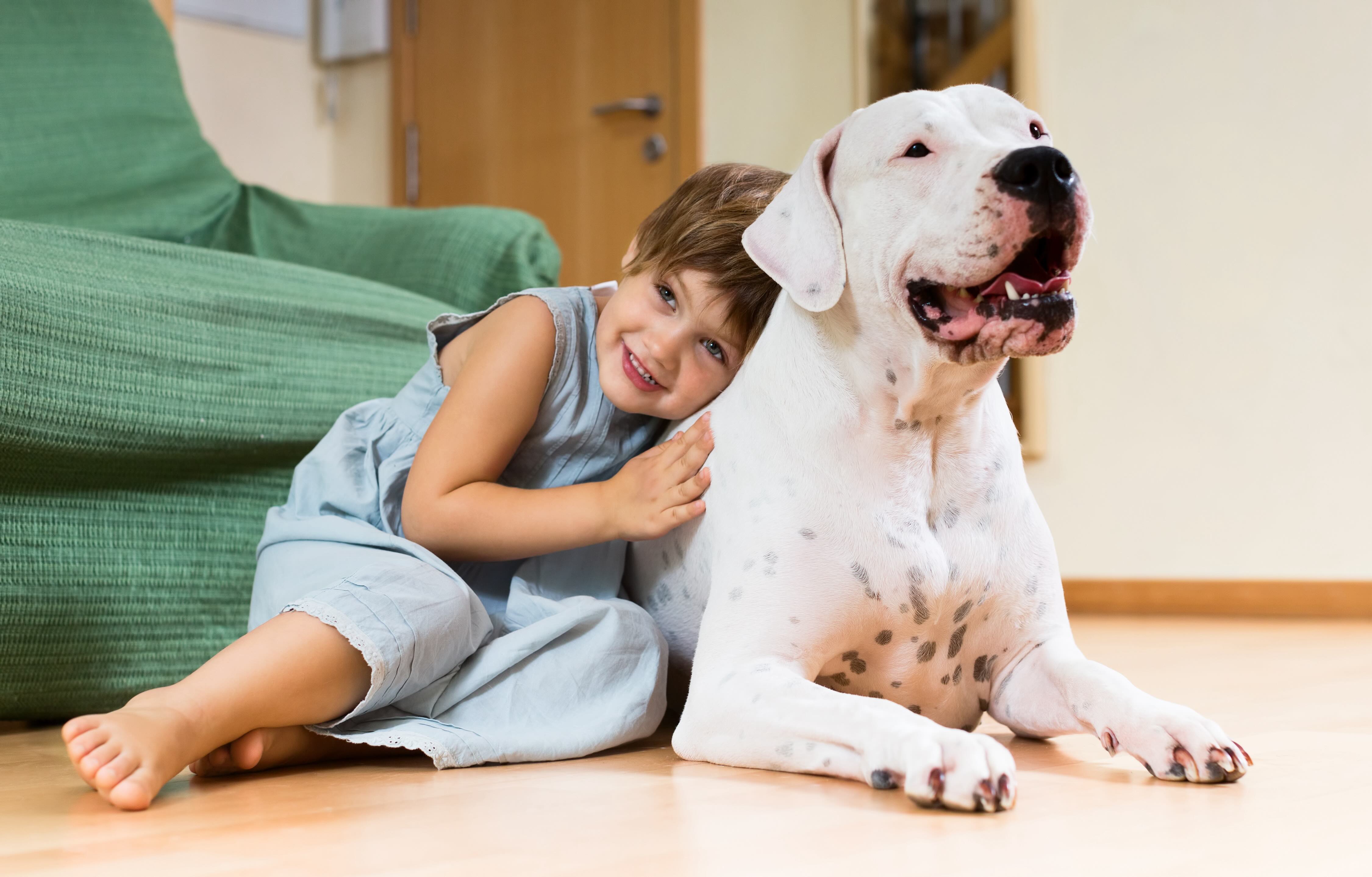
While they can live well with pets they’ve been raised with, it might not be a good idea to bring home a Dogo Argentino puppy if you already have small animals due to the Dogo’s strong prey drive. They also do best in a home with a fenced-in yard to keep them safe when outside, and they are typically not well-suited for apartment living.
These dogs require consistent training and need pet parents that can accommodate their energy requirements, as they become easily bored. They do best with a pet parent who has time to devote to the energy of these dogs.
Ultimately, the Dogo Argentino is a special breed that requires a significant amount of training, physical exercise, and mental enrichment. That said, they make affectionate and loyal partners for pet parents who can meet their needs.
Dogo Argentino FAQs
How much does a Dogo Argentino cost?
The average Dogo Argentino price varies, but you can expect to pay $1,000–$3,000.
Is a Dogo Argentino a good family dog?
With a family that’s equipped to handle the breed’s high energy, prey drive, and training needs, a Dogo Argentino can make a loyal and loving companion.
Are Dogo Argentinos smart dogs?
Yes, Dogo Argentinos are highly intelligent animals. Because of this, they require training that involves significant mental stimulation. They also make wonderful working dogs when trained for military or police work, search and rescue, or service work.
Is a Dogo Argentino a Pit Bull?
While Dogo Argentinos and American Pit Bull Terriers look similar, they are separate dog breeds. The Dogo Argentino was historically developed from crossing many different breeds, including the Boxer, Great Dane, Bull Terrier, Irish Wolfhound, English Pointer, and Dogue de Bordeaux.
Is the Dogo Argentino allowed in the U.S.?
Yes, Dogo Argentinos are legal in the U.S. However, they are banned in a few other countries, including in the U.K.
Cane Corso vs. Dogo Argentino: What’s the difference?
While they are similar in size and appearance, there are differences between a Dogo Argentino and a Cane Corso. One way to tell the breeds apart is by color. Dogo Argentinos are always white, while a Cane Corso can have a black, gray, brindle, or fawn coat.
